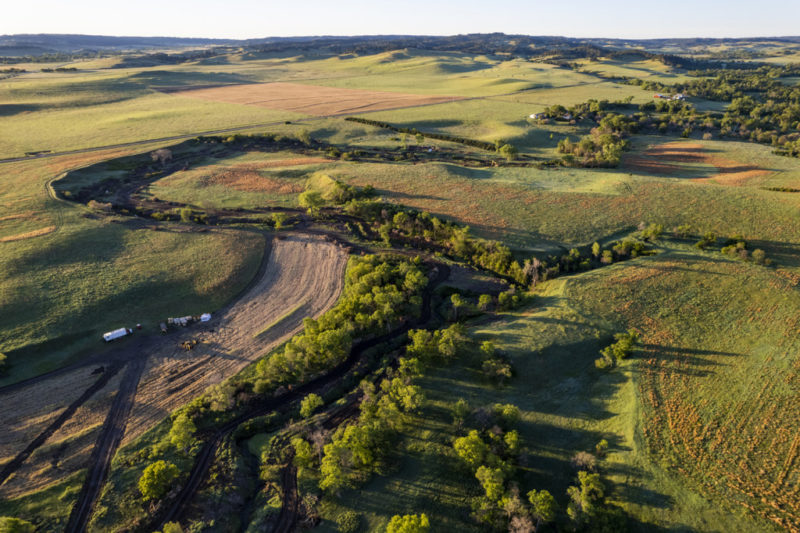![]()
Anglers in Nebraska got a lot accomplished this year — just by buying a fishing permit.
Regardless of their success on the water, their purchase of a permit — and the Aquatic Habitat Stamp that is included — helped fund more than $8 million in improvements through the Nebraska Aquatic Habitat Program in 2022. In essence, they helped bring new life to aging waters.
The program, celebrated its 25th anniversary in 2022, enhances aquatic ecosystems by implementing restoration techniques in streams, lakes, reservoirs and the watersheds that feed them. In addition to improving aquatic habitat and water quality, the program also improves boat and bank angler access.

When the Nebraska Game and Parks Commission established the Aquatic Habitat Program in 1997, it was the only one of its kind in the nation.
“Since its inception, the Aquatic Habitat Program has generated more than $90 million for improvements to 137 water bodies across Nebraska,” said Dean Rosenthal fisheries administrator. “The Commission takes great pride in the improvements we — thanks to partnerships, volunteers and staff — have made so that Nebraska is a tremendous state to fish in. We are committed to maintaining and improving fishing access for anglers.”
Aquatic habitat and angler access improvement work was accomplished throughout the state during 2022. The following is a list of projects completed or nearly completed in 2022 using Aquatic Habitat Program, Sportfish Restoration and Nebraska Environmental Trust funding:
North Platte I-80 Lake – The south side of the lake, the primary entrance to the area, received several upgrades. Five fishing piers were built, and Americans with Disabilities Act access was added to the boat ramp and one pier. Barriers to prevent overgrown vegetation also were installed near these fishing piers.
Valentine National Wildlife Refuge – Carp barriers, which prevent carp from moving into or out of a water body, often can clog with vegetation. Rotating screens were installed to prevent this problem in the outlet structures of Clear and Hackberry lakes.
Grable Pond North at Fort Robinson State Park – This pond, the last in a series of three ponds to be renovated, was deepened along the perimeter. The outlet structure also was replaced and an ADA-access jetty was installed, with fish habitat features placed within casting distance.
I-80 lakes – Russian olive and cedar trees were cleared around West Wood River, Bufflehead, West Brady and East Sutherland wildlife management areas. This opened areas for angler access that had become too overgrown for easy access to the water.
Summit Lake – The sediment basins were excavated on the south and west ends to restore them back to their original capacity and prevent sediment from entering the main reservoir. Angler jetties and the boat ramp also were improved and stabilized, and a kayak launch site was developed.
Bordeaux Creek – This Pine Ridge project was designed to reconnect the creek to the floodplain, ultimately improving bank stability and cool-water fish habitat. These changes, which remain under construction, will improve the trout fishery and fishing access, greatly enhancing recreational opportunities for anglers.
Wagon Train Lake – This project restored the sediment basin to its original capacity and modified the design to improve sediment capture. Habitat shoals and vegetation barriers were added to the reservoir basin, and undesirable fish were removed. The lake is currently being restocked. A boat launch and angler access areas will be repaired in 2023.
Gracie Creek – Flooding from 2019 substantially reduced the capacity of the Gracie Creek Pond near Calamus Reservoir. This project developed a sediment dike to make it easier to remove sediment in the future. It also removed 30,000 yards of sediment from the pond. Habitat and angler access improvements also were made below the outlet, which will provide improved opportunities for anglers fishing for white bass in the spring.
Victoria Springs SRA – Research is being conducted to identify sources of nutrients in the lake that are causing considerable issues with aquatic vegetation and duckweed. These issues have led to fish kills and open water angler access difficulties. Investigations are currently being evaluated to determine feasible management strategies to improve conditions.
Read more about the Aquatic Habitat Program at OutdoorNebraska.gov/aquatichabitatprogram.
